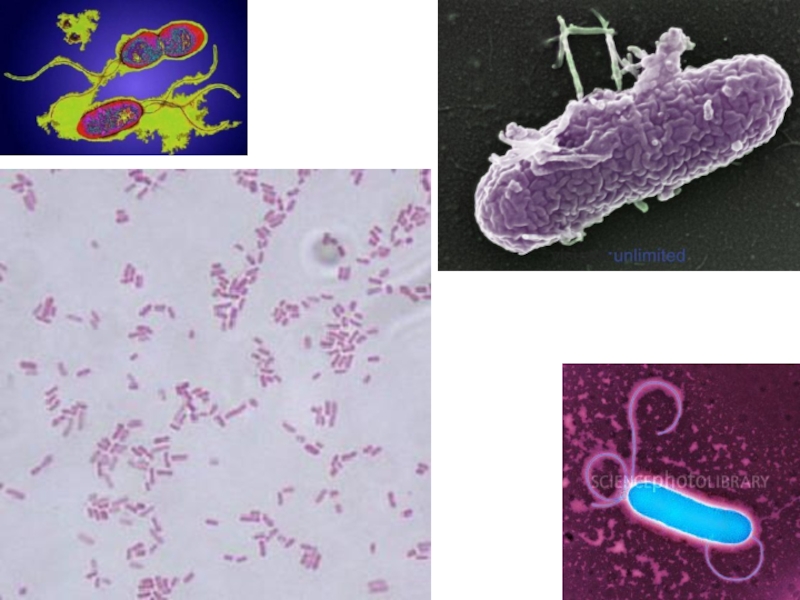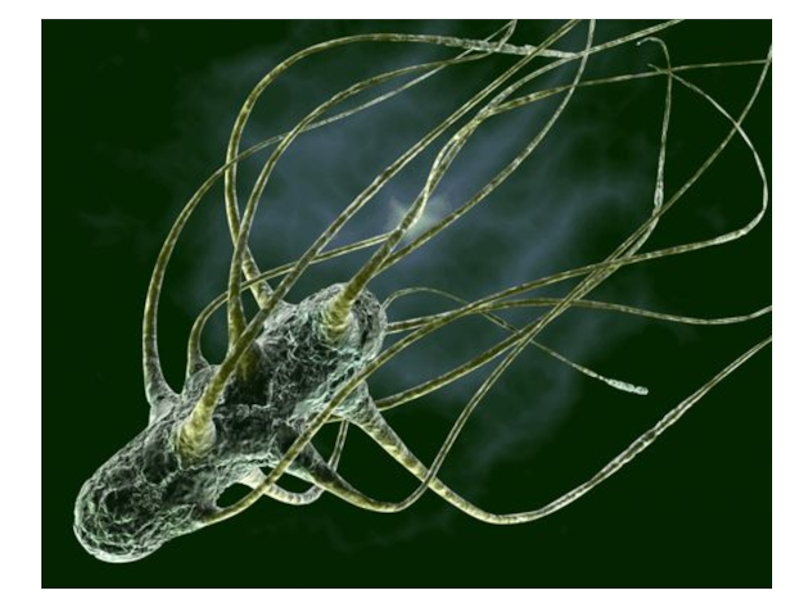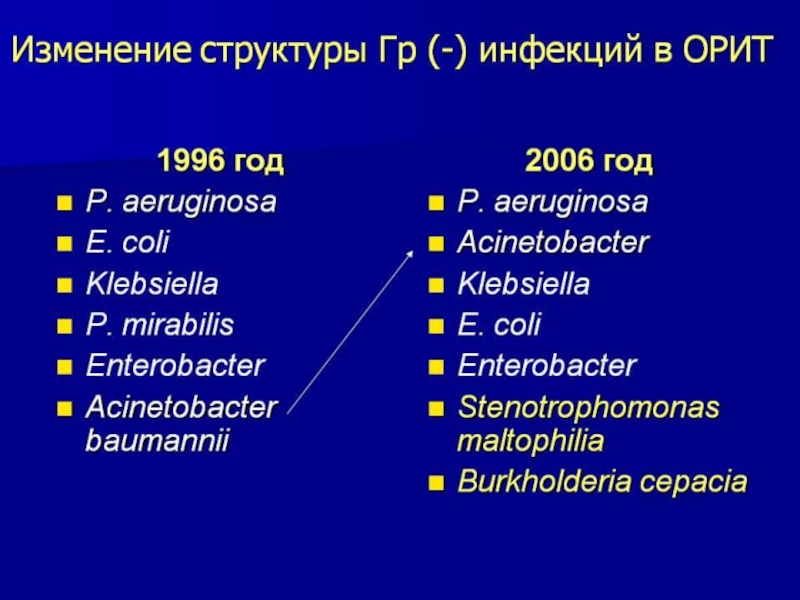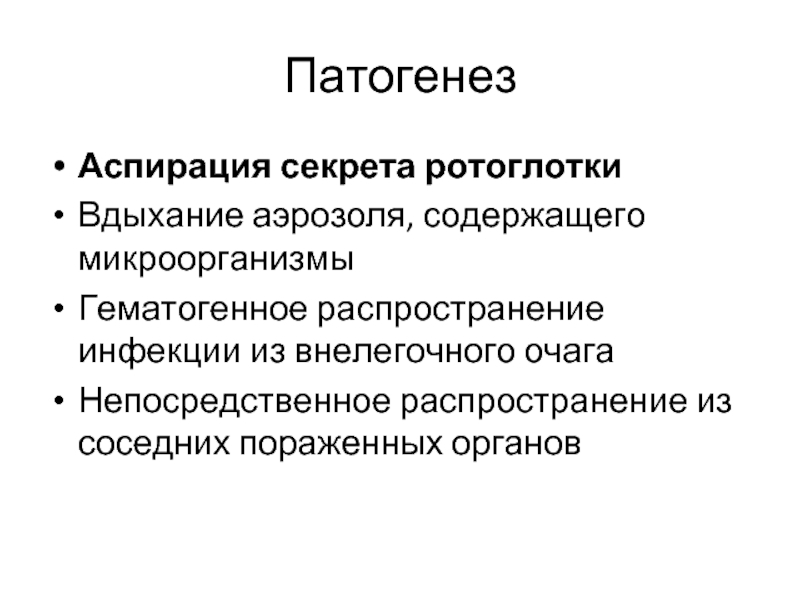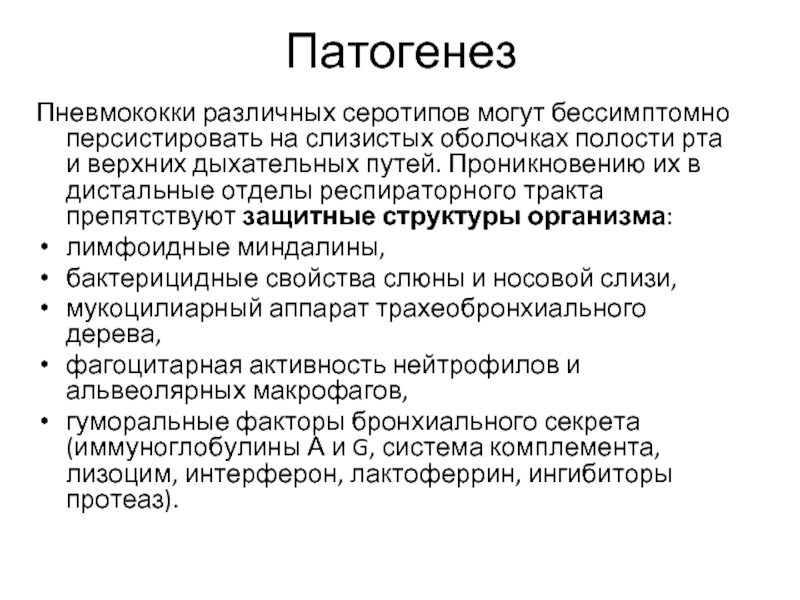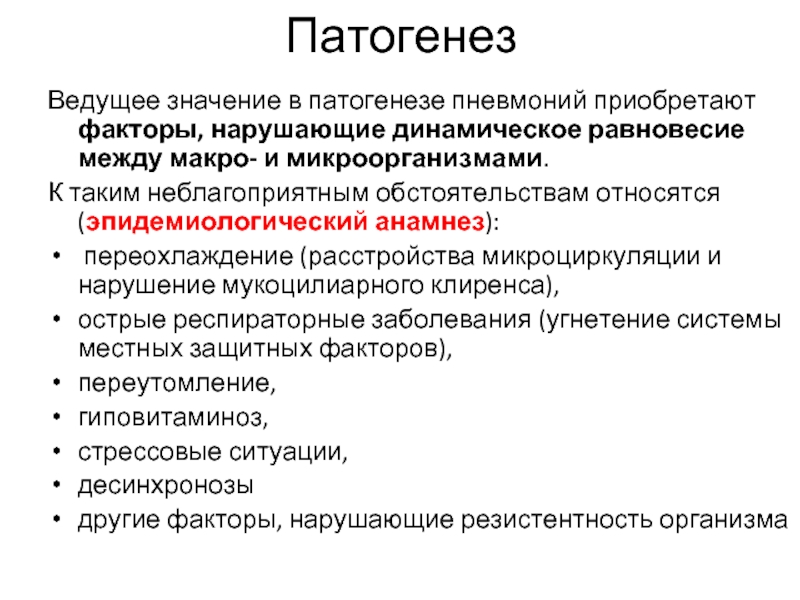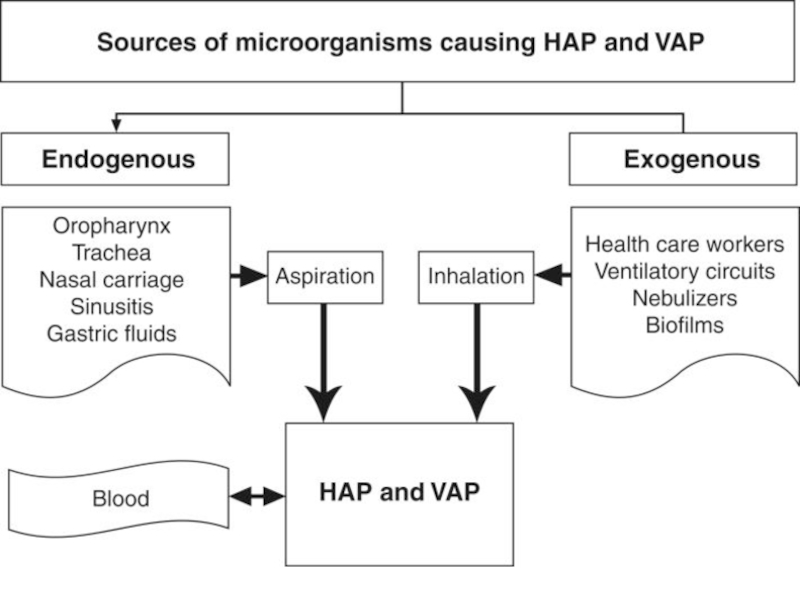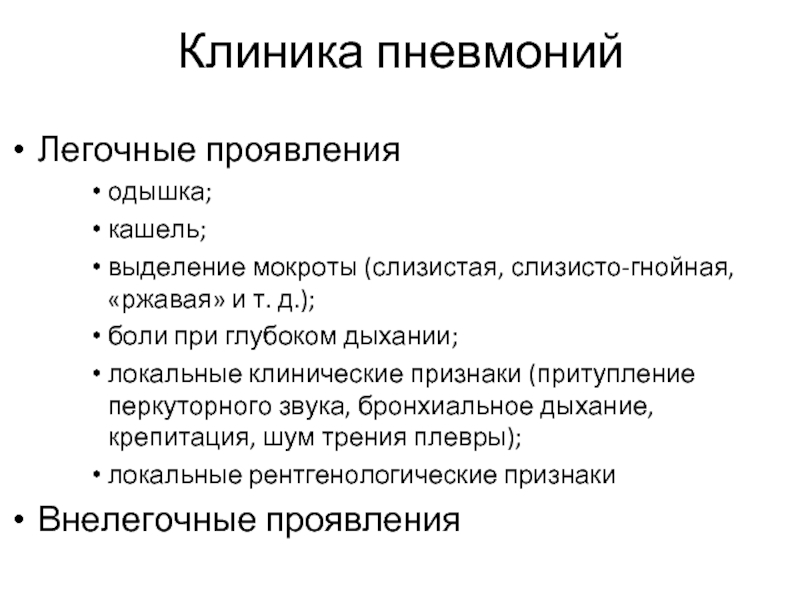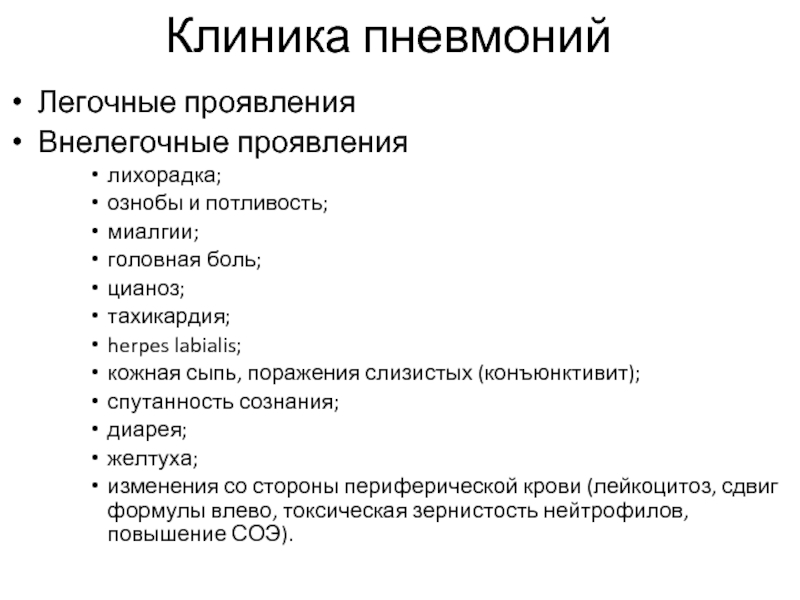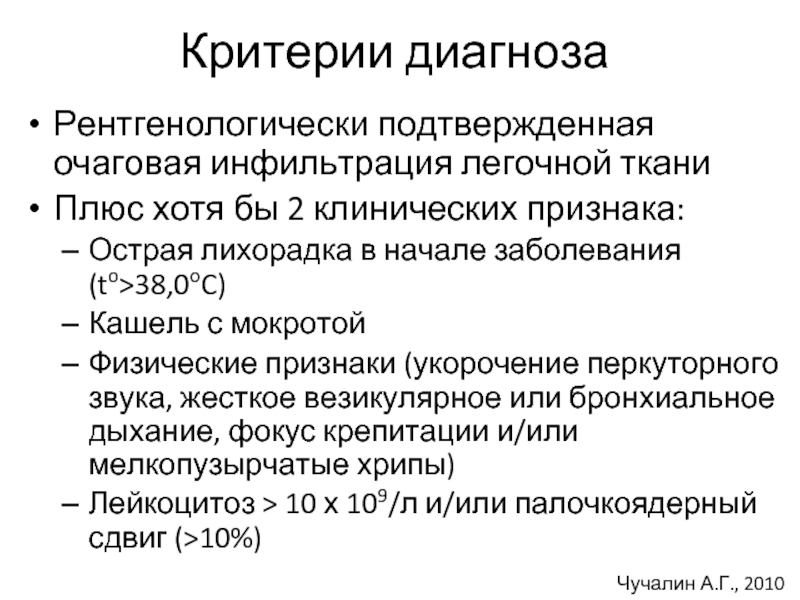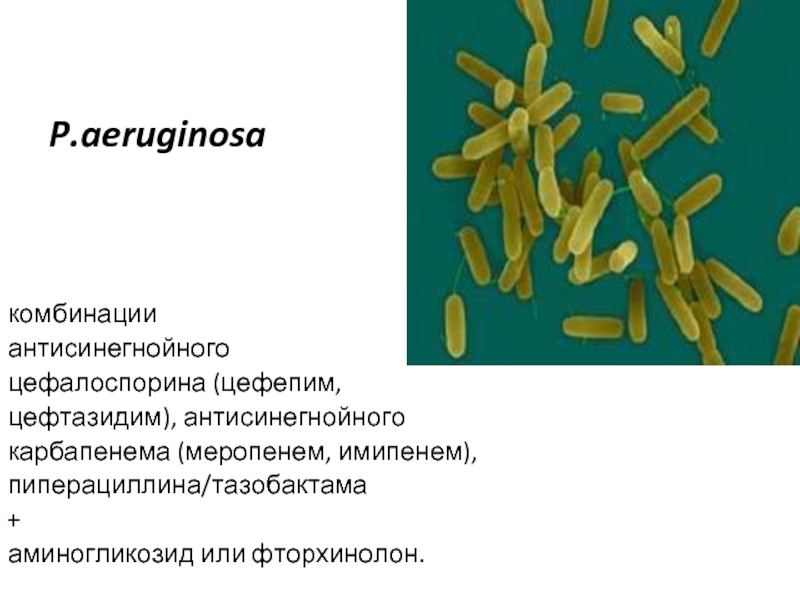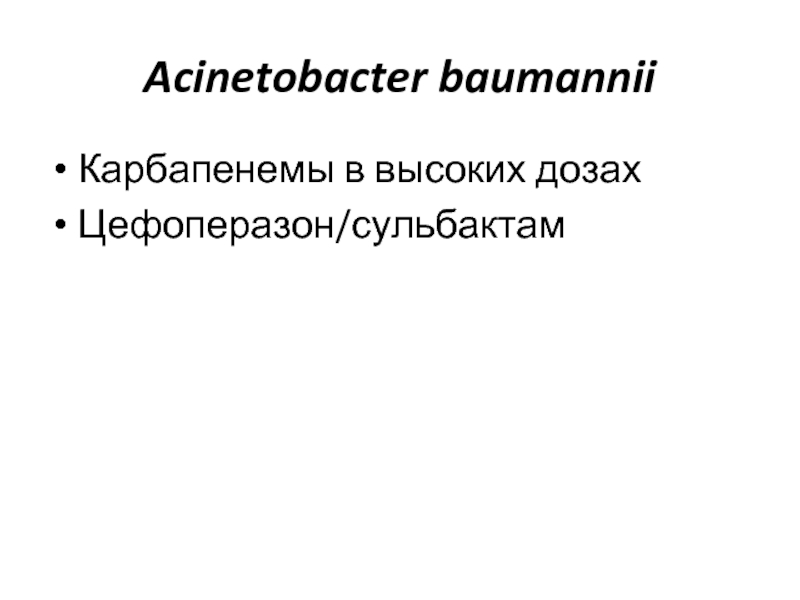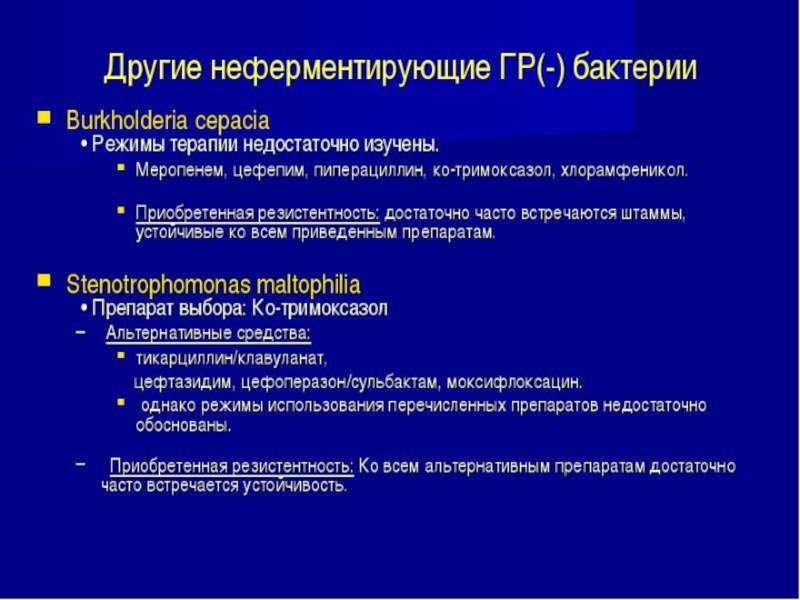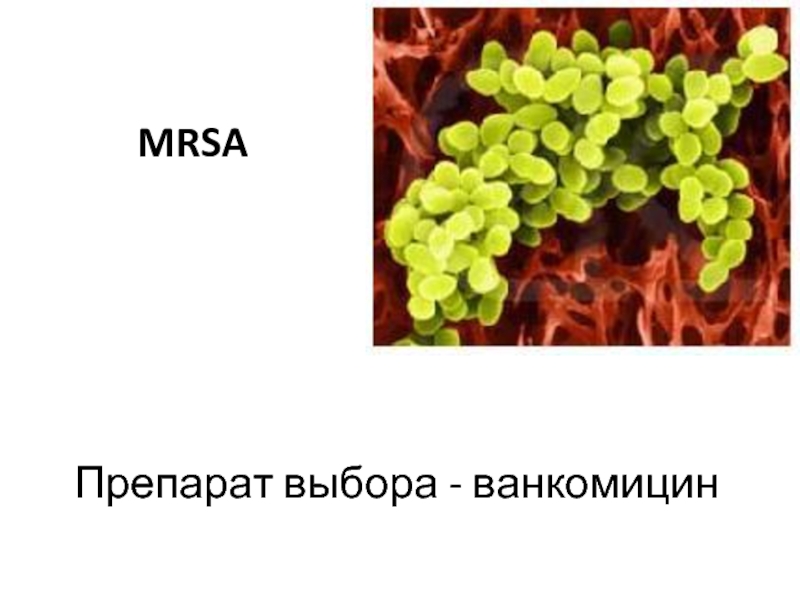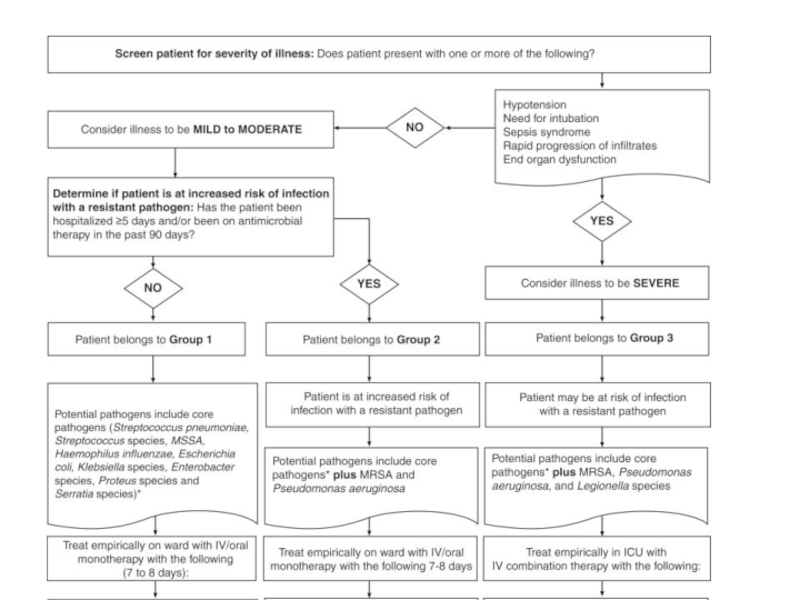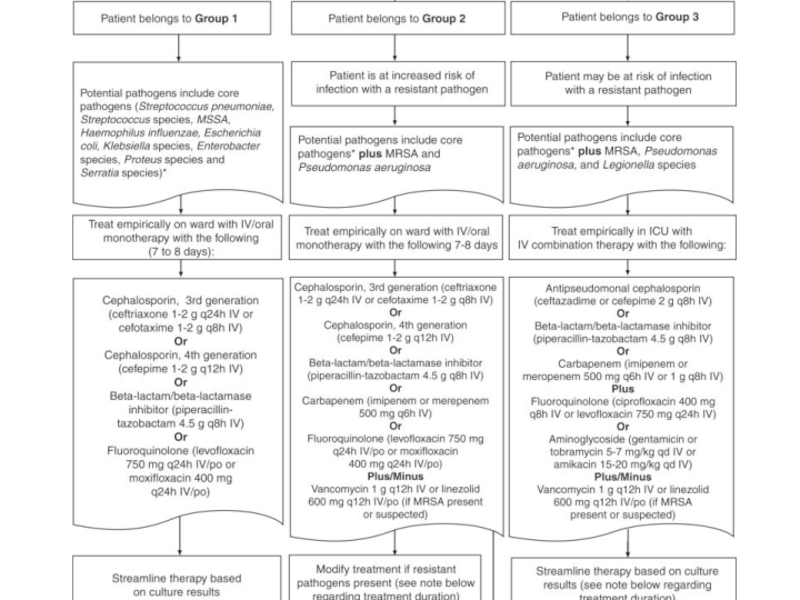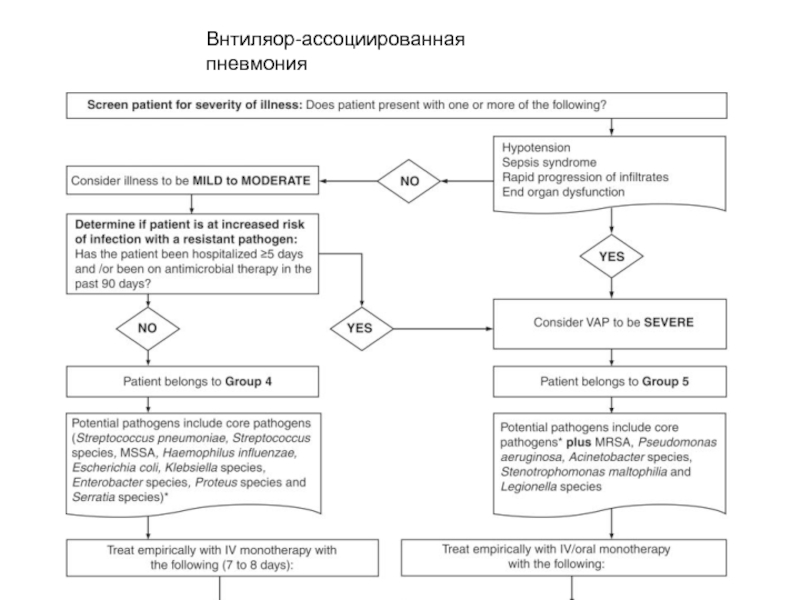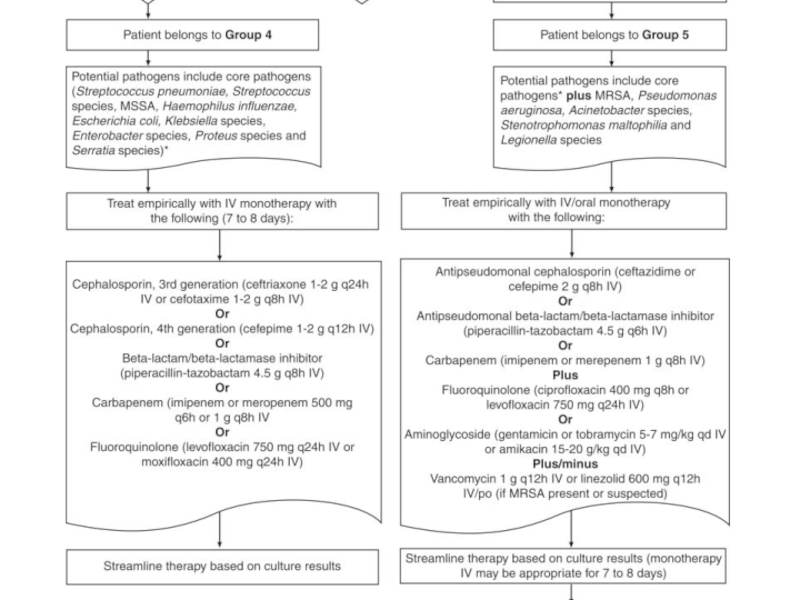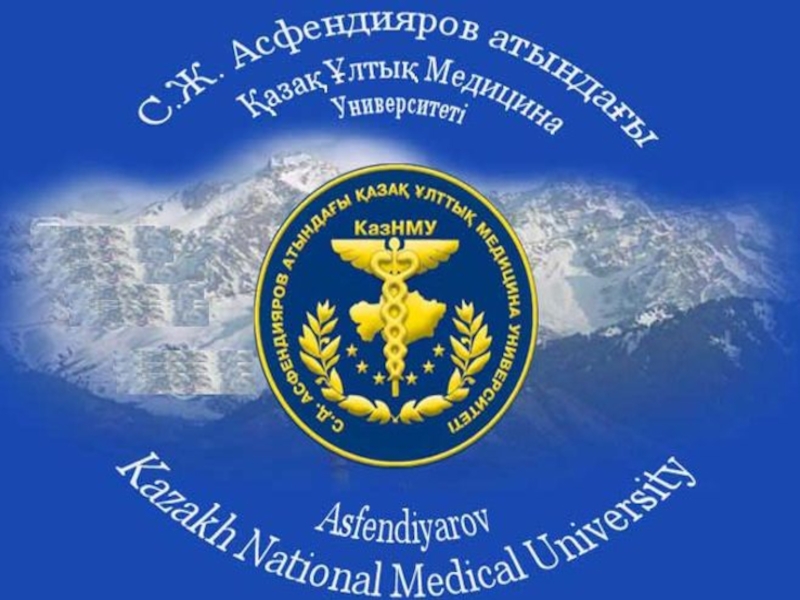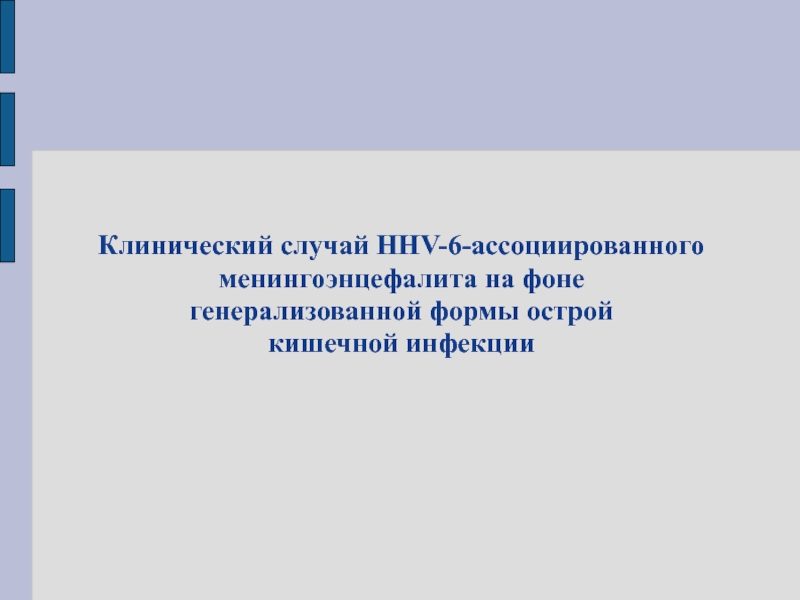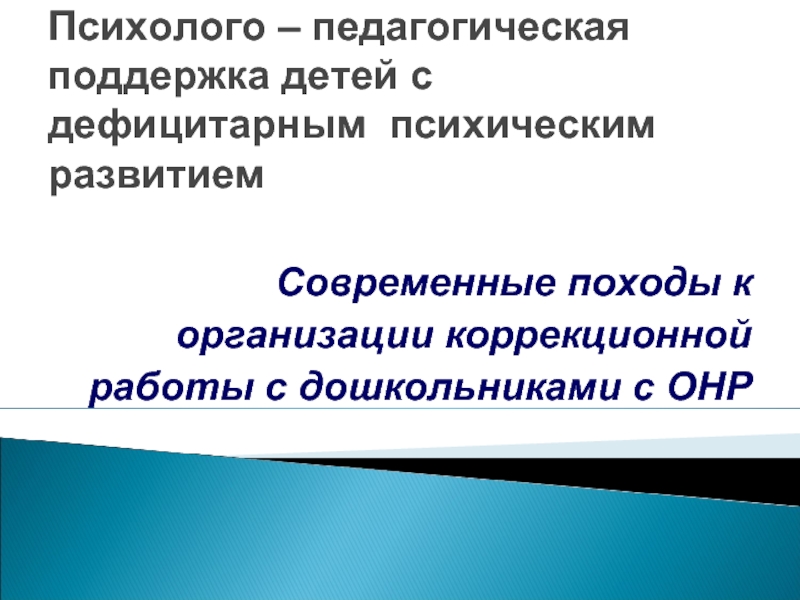- Главная
- Разное
- Дизайн
- Бизнес и предпринимательство
- Аналитика
- Образование
- Развлечения
- Красота и здоровье
- Финансы
- Государство
- Путешествия
- Спорт
- Недвижимость
- Армия
- Графика
- Культурология
- Еда и кулинария
- Лингвистика
- Английский язык
- Астрономия
- Алгебра
- Биология
- География
- Детские презентации
- Информатика
- История
- Литература
- Маркетинг
- Математика
- Медицина
- Менеджмент
- Музыка
- МХК
- Немецкий язык
- ОБЖ
- Обществознание
- Окружающий мир
- Педагогика
- Русский язык
- Технология
- Физика
- Философия
- Химия
- Шаблоны, картинки для презентаций
- Экология
- Экономика
- Юриспруденция
Нозокомиальная пневмония презентация
Содержание
- 1. Нозокомиальная пневмония
- 4. Нозокомиальная (госпитальная, внутрибольничная) пневмония - заболевание, характеризующееся
- 5. Классификация пневмоний (Чучалин А.Г. и др., 2010 г.)
- 6. Классификация пневмоний (Чучалин А.Г. и др., 2010
- 7. Классификация пневмоний (Чучалин А.Г. и др., 2010
- 8. Классификация пневмоний (Чучалин А.Г. и др., 2010
- 9. Эпидемиология НП 5-10 случаев на 1000 госпитализированных
- 10. Этиология НП Энтеробактерии (Klebsiela pneumonia, Escherichia coli, Enterobacter spp.)
- 12. Этиология НП Энтеробактерии (Klebsiela pneumonia, Escherichia coli, Enterobacter spp.) Неферментирующие грам(-) бактерии (P.aeruginosa, Acinetobacter spp.)
- 14. Этиология НП Энтеробактерии (Klebsiela pneumonia, Escherichia coli,
- 16. Этиология НП
- 17. PLoS One. 2013 Sep 17;8(9):e75171. doi: 10.1371/journal.pone.0075171.
- 18. Characteristics of patients with healthcare-associated (HCAP), hospital-acquired
- 19. Characteristics of patients with healthcare-associated (HCAP), hospital-acquired
- 20. Characteristics of patients with healthcare-associated (HCAP), hospital-acquired
- 21. Multivariate analysis of variables associated with 30-day
- 22. Int J Infect Dis. 2013 Sep 11.
- 23. ЦЕЛЬ: Целью данного исследования было описать
- 26. Внтиляор-ассоциированная пневмония
- 27. Нозокомиальная пневмония
- 29. Microbiological causes of hospital-acquired pneumonia and ventilator-associated pneumonia (level A-2)
- 30. Род Stenotrophomonas включает 5 видов [25], из
- 35. Патогенез Аспирация секрета ротоглотки Вдыхание аэрозоля, содержащего
- 36. Патогенез В 1 мл слюны содержится до 1 млрд.
- 37. Патогенез Пневмококки различных серотипов могут бессимптомно персистировать
- 38. Патогенез Ведущее значение в патогенезе пневмоний приобретают
- 40. Клиника пневмоний Легочные проявления одышка; кашель; выделение
- 41. Клиника пневмоний Легочные проявления Внелегочные проявления лихорадка;
- 42. Диагностика Золотого стандарта не существует Клинико-бактериологическая стратегия
- 43. Критерии диагноза Рентгенологически подтвержденная очаговая инфильтрация легочной
- 44. Основные принципы лечения НП Незамедлительное начало антибактериальной
- 45. комбинации антисинегнойного цефалоспорина (цефепим,
- 46. Acinetobacter baumannii Карбапенемы в высоких дозах Цефоперазон/сульбактам
- 48. Грам(-) бактерии – продуценты БЛРС Препарат выбора - карбапенемы
- 49. MRSA Препарат выбора - ванкомицин
- 52. Внтиляор-ассоциированная пневмония
- 54. Спасибо за внимание!
Слайд 4Нозокомиальная (госпитальная, внутрибольничная) пневмония - заболевание, характеризующееся появлением на рентгенограмме «свежих»
Слайд 6Классификация пневмоний (Чучалин А.Г. и др., 2010 г.)
1. Внебольничная пневмония:
I. Типичная
а) бактериальная;
б) вирусная;
в) грибковая;
г) микобактериальная;
д) паразитарная.
II. У пациентов с выраженными нарушениями иммунитета:
а) синдром приобретенного иммунодефицита (СПИД);
б) прочие заболевания/патологические состояния.
III. Аспирационная пневмония/абсцесс легкого.
Слайд 7Классификация пневмоний (Чучалин А.Г. и др., 2010 г.)
2. Нозокомиальная пневмония:
Собственно нозокомиальная
II. Вентиляторассоциированная пневмония.
III. Нозокомиальная пневмония у пациентов с выраженными нарушениями иммунитета:
а) у реципиентов донорских органов;
б) у пациентов, получающих цитостатическую терапию.
Слайд 8Классификация пневмоний (Чучалин А.Г. и др., 2010 г.)
3. Пневмония, связанная с
Пневмония у обитателей домов престарелых
II. Прочие категории пациентов:
а) антибактериальная терапия в предшествующие 3 мес.;
б) госпитализация (по любому поводу) в течение ≥ 2 суток в предшествующие 90 дней;
в) пребывание в других учреждениях длительного ухода;
г) хронический диализ в течение ≥ 30 суток;
д) обработка раневой поверхности в домашних условиях;
е) иммунодефицитные состояния/заболевания.
Слайд 9Эпидемиология НП
5-10 случаев на 1000 госпитализированных
У пациентов на ИВЛ риск НП
Летальность при НП колеблется от 30 до 71%
Слайд 12Этиология НП
Энтеробактерии (Klebsiela pneumonia, Escherichia coli, Enterobacter spp.)
Неферментирующие грам(-) бактерии (P.aeruginosa,
Слайд 14Этиология НП
Энтеробактерии (Klebsiela pneumonia, Escherichia coli, Enterobacter spp.)
Неферментирующие грам(-) бактерии (P.aeruginosa,
Грам(+) кокки (S.aureus, Streptococcus pneumoniae)
Слайд 17PLoS One. 2013 Sep 17;8(9):e75171. doi: 10.1371/journal.pone.0075171.
Epidemiology and Outcome of Pneumonia
Tadros MTadros M, Williams VTadros M, Williams V, Coleman BLTadros M, Williams V, Coleman BL, McGeer AJTadros M, Williams V, Coleman BL, McGeer AJ, Haider STadros M, Williams V, Coleman BL, McGeer AJ, Haider S, Lee CTadros M, Williams V, Coleman BL, McGeer AJ, Haider S, Lee C, Iacovides HTadros M, Williams V, Coleman BL, McGeer AJ, Haider S, Lee C, Iacovides H, Rubinstein ETadros M, Williams V, Coleman BL, McGeer AJ, Haider S, Lee C, Iacovides H, Rubinstein E, John MTadros M, Williams V, Coleman BL, McGeer AJ, Haider S, Lee C, Iacovides H, Rubinstein E, John M, Johnston LTadros M, Williams V, Coleman BL, McGeer AJ, Haider S, Lee C, Iacovides H, Rubinstein E, John M, Johnston L, McNeil STadros M, Williams V, Coleman BL, McGeer AJ, Haider S, Lee C, Iacovides H, Rubinstein E, John M, Johnston L, McNeil S, Katz KTadros M, Williams V, Coleman BL, McGeer AJ, Haider S, Lee C, Iacovides H, Rubinstein E, John M, Johnston L, McNeil S, Katz K, Laffin NTadros M, Williams V, Coleman BL, McGeer AJ, Haider S, Lee C, Iacovides H, Rubinstein E, John M, Johnston L, McNeil S, Katz K, Laffin N, Suh KNTadros M, Williams V, Coleman BL, McGeer AJ, Haider S, Lee C, Iacovides H, Rubinstein E, John M, Johnston L, McNeil S, Katz K, Laffin N, Suh KN, Powis JTadros M, Williams V, Coleman BL, McGeer AJ, Haider S, Lee C, Iacovides H, Rubinstein E, John M, Johnston L, McNeil S, Katz K, Laffin N, Suh KN, Powis J, Smith STadros M, Williams V, Coleman BL, McGeer AJ, Haider S, Lee C, Iacovides H, Rubinstein E, John M, Johnston L, McNeil S, Katz K, Laffin N, Suh KN, Powis J, Smith S, Taylor GTadros M, Williams V, Coleman BL, McGeer AJ, Haider S, Lee C, Iacovides H, Rubinstein E, John M, Johnston L, McNeil S, Katz K, Laffin N, Suh KN, Powis J, Smith S, Taylor G, Watt CTadros M, Williams V, Coleman BL, McGeer AJ, Haider S, Lee C, Iacovides H, Rubinstein E, John M, Johnston L, McNeil S, Katz K, Laffin N, Suh KN, Powis J, Smith S, Taylor G, Watt C, Simor AE.
Source
University of Toronto, Toronto, Ontario, Canada.
Abstract
BACKGROUND:
MRSA remains a leading cause of hospital-acquired (HAP) and healthcare-associated pneumonia (HCAP). We describe the epidemiology and outcome of MRSA pneumonia in Canadian hospitals, and identify factors contributing to mortality.
METHODS:
Prospective surveillance for MRSA pneumonia in adults was done for one year (2011) in 11 Canadian hospitals. Standard criteria for MRSA HAP, HCAP, ventilator-associated pneumonia (VAP), and community-acquired pneumonia (CAP) were used to identify cases. MRSA isolates underwent antimicrobial susceptibility testing, and were characterized by pulsed-field gel electrophoresis (PFGE) and Panton-Valentine leukocidin (PVL) gene detection. The primary outcome was all-cause mortality at 30 days. A multivariable analysis was done to examine the association between various host and microbial factors and mortality.
RESULTS:
A total of 161 patients with MRSA pneumonia were identified: 90 (56%) with HAP, 26 (16%) HCAP, and 45 (28%) CAP; 23 (14%) patients had VAP. The mean (± SD) incidence of MRSA HAP was 0.32 (± 0.26) per 10,000 patient-days, and of MRSA VAP was 0.30 (± 0.5) per 1,000 ventilator-days. The 30-day all-cause mortality was 28.0%. In multivariable analysis, variables associated with mortality were the presence of multiorgan failure (OR 8.1; 95% CI 2.5-26.0), and infection with an isolate with reduced susceptibility to vancomycin (OR 2.5, 95% CI 1.0-6.3).
CONCLUSIONS:
MRSA pneumonia is associated with significant mortality. Severity of disease at presentation, and infection caused by an isolate with elevated MIC to vancomcyin are associated with increased mortality. Additional studies are required to better understand the impact of host and microbial variables on outcome.
Слайд 18Characteristics of patients with healthcare-associated (HCAP), hospital-acquired (HAP), and community-acquired (CAP)
Слайд 19Characteristics of patients with healthcare-associated (HCAP), hospital-acquired (HAP), and community-acquired (CAP)
PLoS One. 2013 Sep 17;8(9):e75171.
Tadros M et al., et al.
Слайд 20Characteristics of patients with healthcare-associated (HCAP), hospital-acquired (HAP), and community-acquired (CAP)
PLoS One. 2013 Sep 17;8(9):e75171.
Tadros M et al., et al.
Слайд 21Multivariate analysis of variables associated with 30-day all-cause mortality in patient
PLoS One. 2013 Sep 17;8(9):e75171.
Tadros M et al., et al.
Слайд 22Int J Infect Dis. 2013 Sep 11. pii: S1201-9712(13)00249-X. doi: 10.1016/j.ijid.2013.07.014.
Acinetobacter baumannii ventilator-associated pneumonia: epidemiology, clinical characteristics, and prognosis factors.
Chaari AChaari A, Mnif BChaari A, Mnif B, Bahloul MChaari A, Mnif B, Bahloul M, Mahjoubi FChaari A, Mnif B, Bahloul M, Mahjoubi F, Chtara KChaari A, Mnif B, Bahloul M, Mahjoubi F, Chtara K, Turki OChaari A, Mnif B, Bahloul M, Mahjoubi F, Chtara K, Turki O, Gharbi NChaari A, Mnif B, Bahloul M, Mahjoubi F, Chtara K, Turki O, Gharbi N, Chelly HChaari A, Mnif B, Bahloul M, Mahjoubi F, Chtara K, Turki O, Gharbi N, Chelly H, Hammami AChaari A, Mnif B, Bahloul M, Mahjoubi F, Chtara K, Turki O, Gharbi N, Chelly H, Hammami A, Bouaziz M.
Source
Intensive Care Unit, Faculty of Medicine, University of Sfax, Hôpital Habib Bourguiba, Route el Ain Km 1, 3029 Sfax, Tunisia. Electronic address: anischaari2004@yahoo.fr.
Abstract
OBJECTIVE:
The aim of this study was to describe the epidemiological characteristics of Acinetobacter baumannii ventilator-associated pneumonia (VAP) and to identify factors predictive of a poor outcome.
METHODS:
A retrospective study was conducted over 16 months in a Tunisian intensive care unit (ICU). All adult patients with A. baumannii VAP were included.
RESULTS:
Ninety-two patients were included in they study; 41 (44.6%) were admitted because of multiple trauma. The mean age of the patients was 44.5±19.5 years. All patients needed mechanical ventilation on admission. The mean SAPS II score was 39±15. The mean delay before VAP onset was 8.1±4.7 days. On VAP onset, 57 patients (62%) developed septic shock. Only 14.2% of isolated strains were susceptible to imipenem; none were resistant to colistin. The mean duration of mechanical ventilation was 20±11 days. The mean duration of ICU stay was 24.3±18.7 days. ICU mortality was 60.9%. In the multivariate analysis, factors predictive of a poor outcome were previously known hypertension (odds ratio 5.8, 95% confidence interval 1.4-24.9; p=0.018) and VAP-related septic shock (odds ratio 8.5, 95% confidence interval 3-23.7; p<0.001).
CONCLUSION:
A. baumannii VAP is associated with a high mortality. Hemodynamic impairment is predictive of a poor outcome.
Слайд 23ЦЕЛЬ: Целью данного исследования было описать эпидемиологическая характеристика Acinetobacter baumannii вентилятор-ассоциированной пневмонии
Слайд 29Microbiological causes of hospital-acquired pneumonia and ventilator-associated pneumonia (level A-2)
Слайд 30Род Stenotrophomonas включает 5 видов [25], из которых клинически значимым к
Биологическая характеристика S. maltophilia – грамотрицательные палочки длиной 0,5 – 1,5 мкм, облигатные аэробы. На плотных средах колонии гладкие, блестящие, с ровными краями и коричневатым или зеленоватым (на кровяном агаре) пигментом, лактозоотрицательные колонии на средах Эндо и Левина. На кровяном агаре бета-гемолиз в течение первых двух суток отсутствует. Оптимальная температура роста - 35° С. Подвижны за счет полярных жгутиков. Для большинства штаммов метионин или цистин являются обязательными ростовыми факторами [25,26]. Штаммы S. maltophilia не способны к ферментации глюкозы и других углеводов, метаболически мало активны, являются оксидазо-отрицательными, каталазо-положительными, обладают лизин-декарбоксилазой, гидролизуют эскулин, желатин, твин 80, ДНК. Глюкоза и некоторые другие углеводы могут служить источниками углерода для роста [2]
Слайд 35Патогенез
Аспирация секрета ротоглотки
Вдыхание аэрозоля, содержащего микроорганизмы
Гематогенное распространение инфекции из внелегочного очага
Непосредственное
Слайд 36Патогенез
В 1 мл слюны содержится до 1 млрд. бактерий, поэтому аспирация даже одной
Слайд 37Патогенез
Пневмококки различных серотипов могут бессимптомно персистировать на слизистых оболочках полости рта
лимфоидные миндалины,
бактерицидные свойства слюны и носовой слизи,
мукоцилиарный аппарат трахеобронхиального дерева,
фагоцитарная активность нейтрофилов и альвеолярных макрофагов,
гуморальные факторы бронхиального секрета (иммуноглобулины А и G, система комплемента, лизоцим, интерферон, лактоферрин, ингибиторы протеаз).
Слайд 38Патогенез
Ведущее значение в патогенезе пневмоний приобретают факторы, нарушающие динамическое равновесие между
К таким неблагоприятным обстоятельствам относятся (эпидемиологический анамнез):
переохлаждение (расстройства микроциркуляции и нарушение мукоцилиарного клиренса),
острые респираторные заболевания (угнетение системы местных защитных факторов),
переутомление,
гиповитаминоз,
стрессовые ситуации,
десинхронозы
другие факторы, нарушающие резистентность организма
Слайд 40Клиника пневмоний
Легочные проявления
одышка;
кашель;
выделение мокроты (слизистая, слизисто-гнойная, «ржавая» и т. д.);
боли при
локальные клинические признаки (притупление перкуторного звука, бронхиальное дыхание, крепитация, шум трения плевры);
локальные рентгенологические признаки
Внелегочные проявления
Слайд 41Клиника пневмоний
Легочные проявления
Внелегочные проявления
лихорадка;
ознобы и потливость;
миалгии;
головная боль;
цианоз;
тахикардия;
herpes labialis;
кожная сыпь, поражения слизистых
спутанность сознания;
диарея;
желтуха;
изменения со стороны периферической крови (лейкоцитоз, сдвиг формулы влево, токсическая зернистость нейтрофилов, повышение СОЭ).
Слайд 43Критерии диагноза
Рентгенологически подтвержденная очаговая инфильтрация легочной ткани
Плюс хотя бы 2
Острая лихорадка в начале заболевания (to>38,0oC)
Кашель с мокротой
Физические признаки (укорочение перкуторного звука, жесткое везикулярное или бронхиальное дыхание, фокус крепитации и/или мелкопузырчатые хрипы)
Лейкоцитоз > 10 х 109/л и/или палочкоядерный сдвиг (>10%)
Чучалин А.Г., 2010
Слайд 44Основные принципы лечения НП
Незамедлительное начало антибактериальной терапии.
Адекватная стартовая антибактериальная терапия.
Деэскалация терапии в максимально ранние сроки.
Слайд 45комбинации
антисинегнойного
цефалоспорина (цефепим,
цефтазидим), антисинегнойного
карбапенема (меропенем, имипенем),
пиперациллина/тазобактама
+
аминогликозид
P.aeruginosa

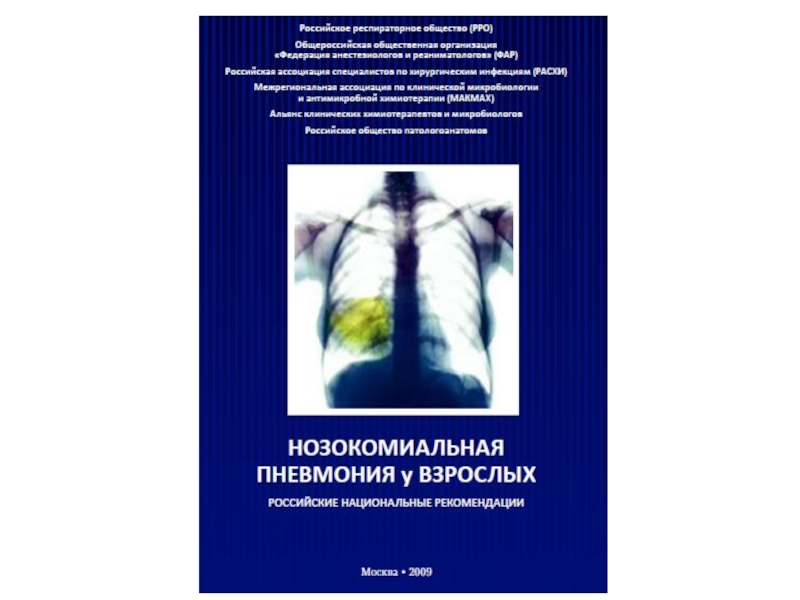
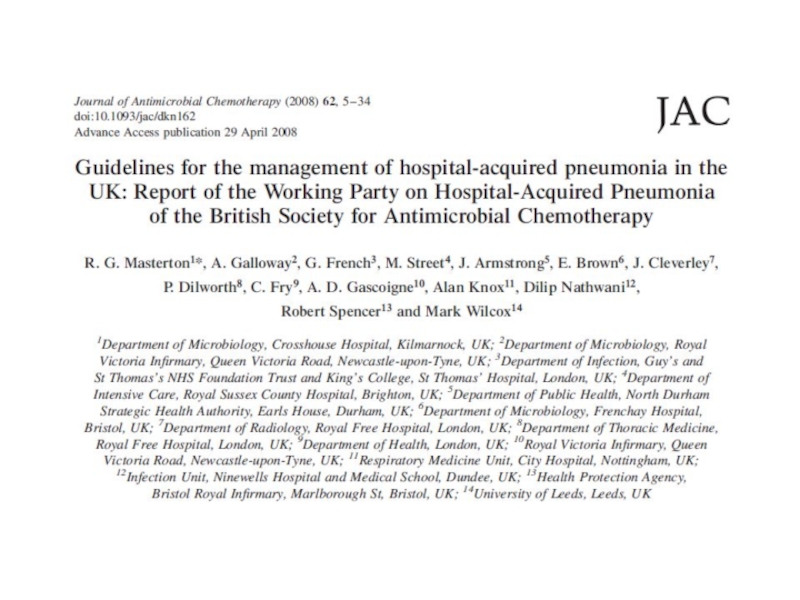
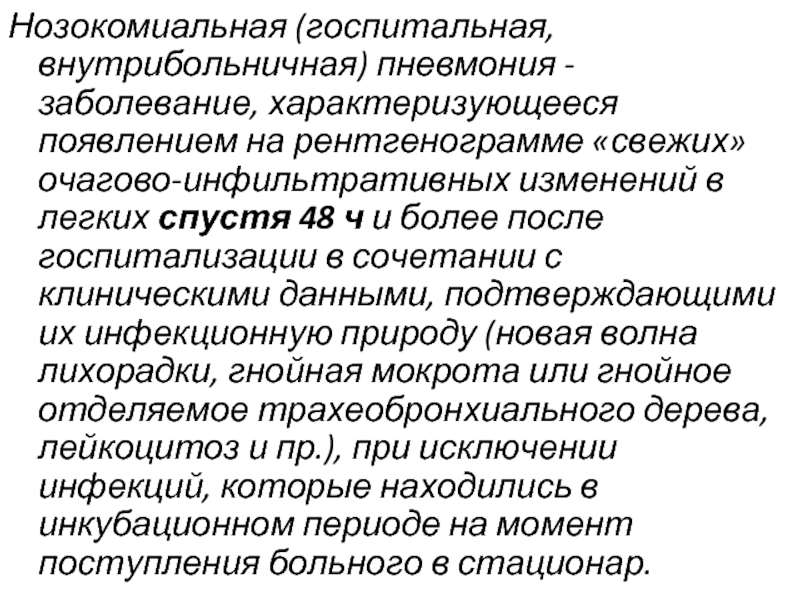
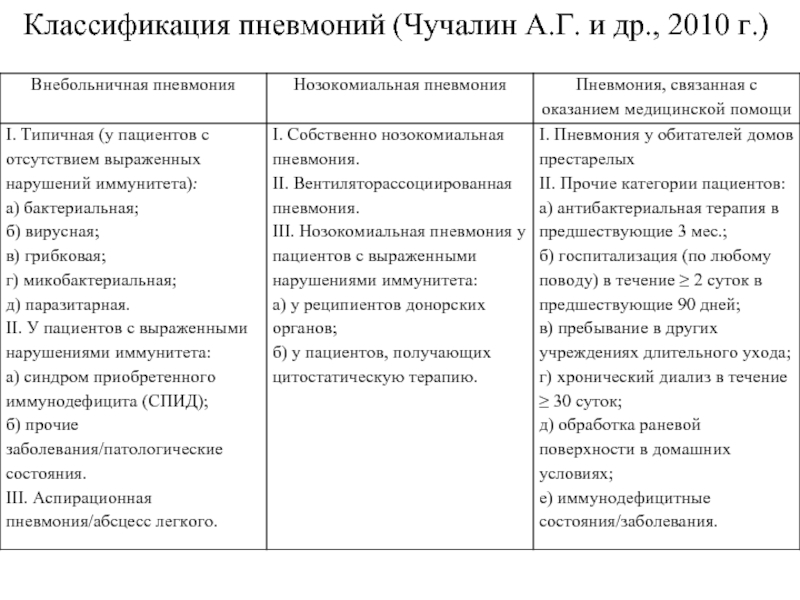
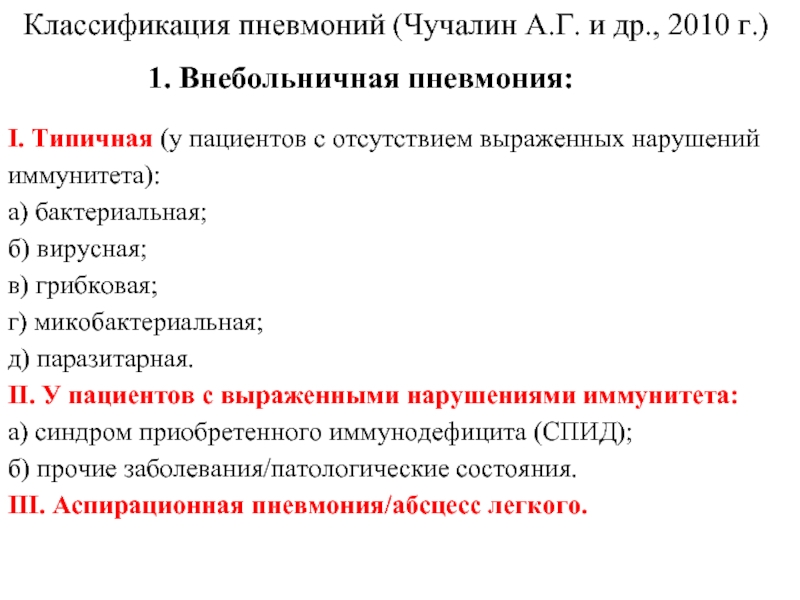

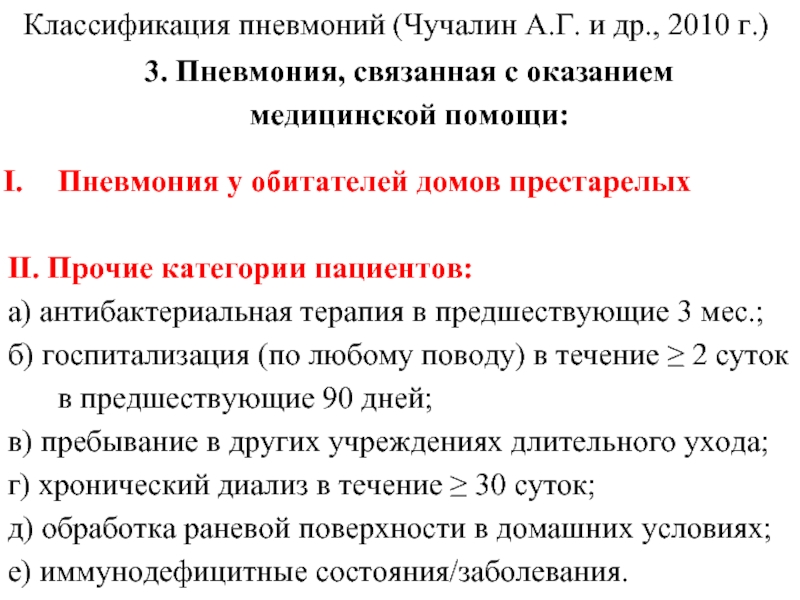
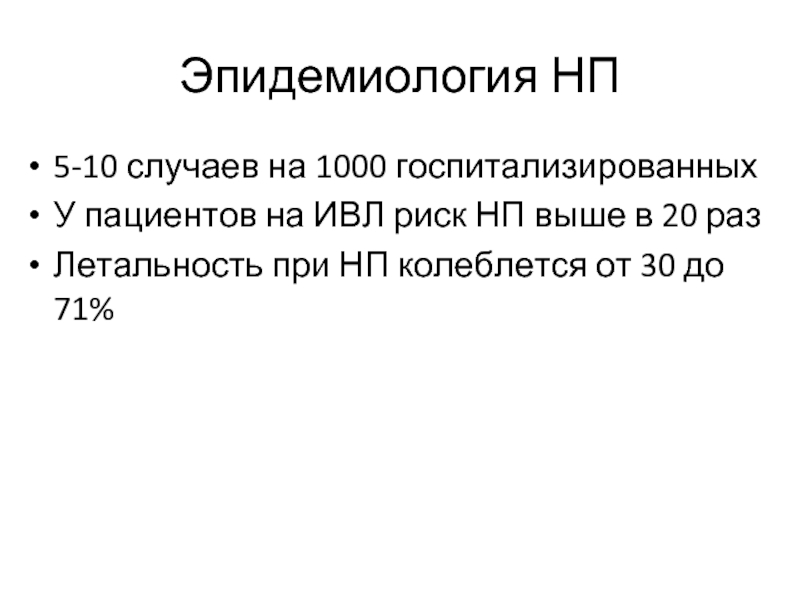
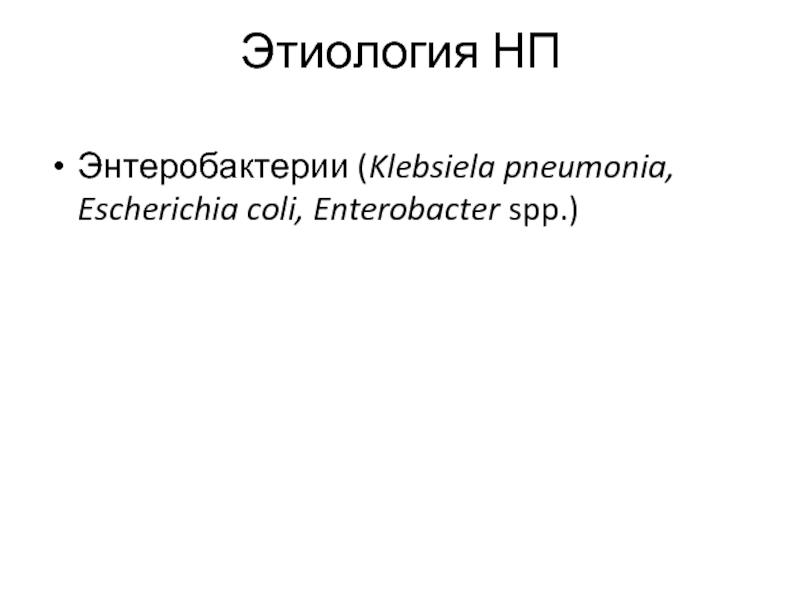

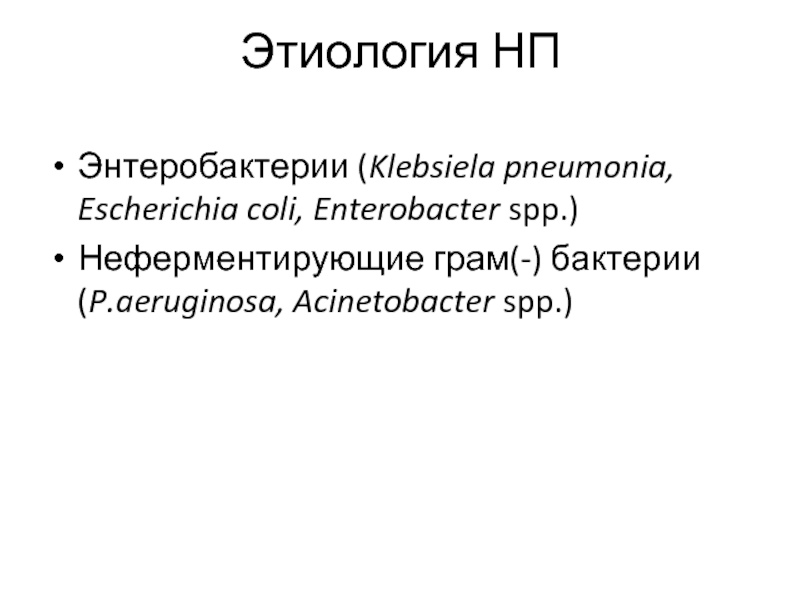
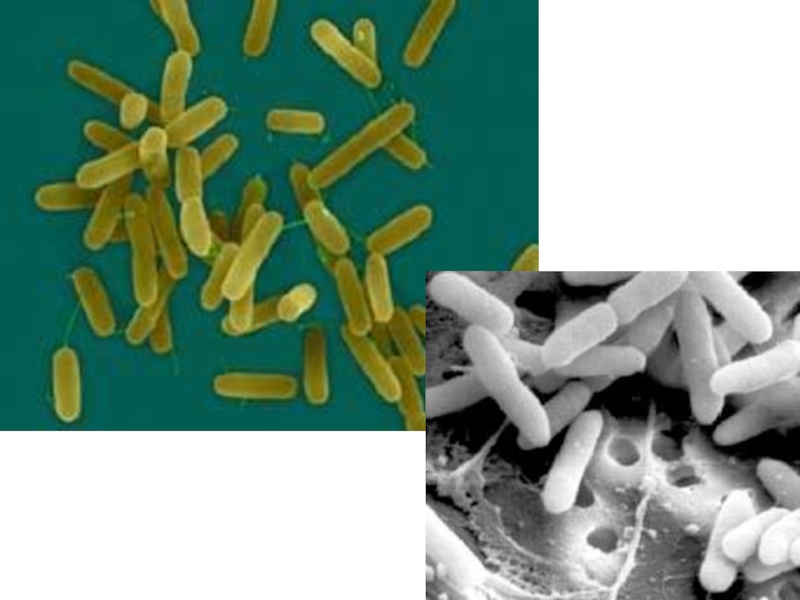
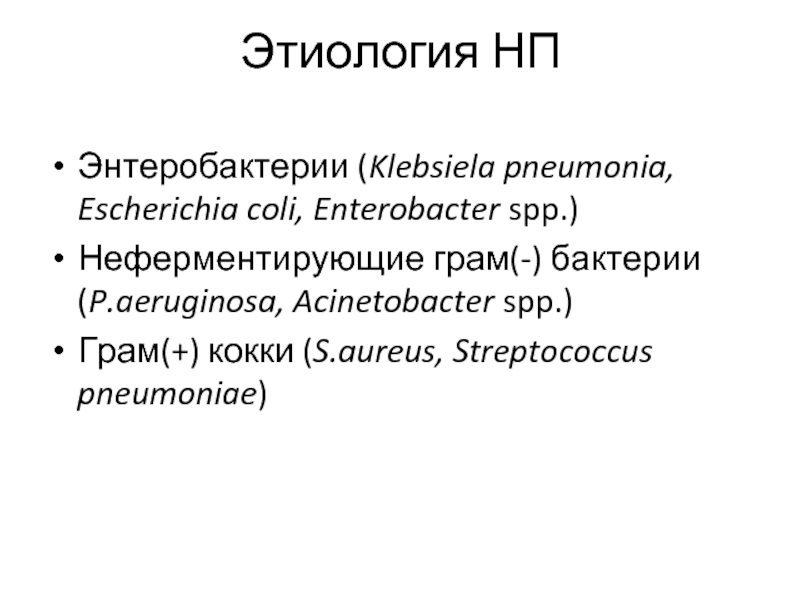
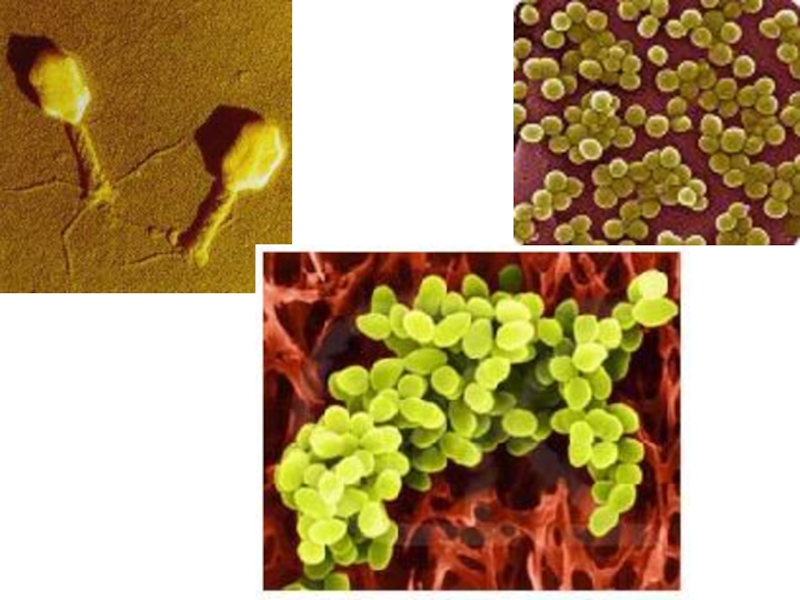
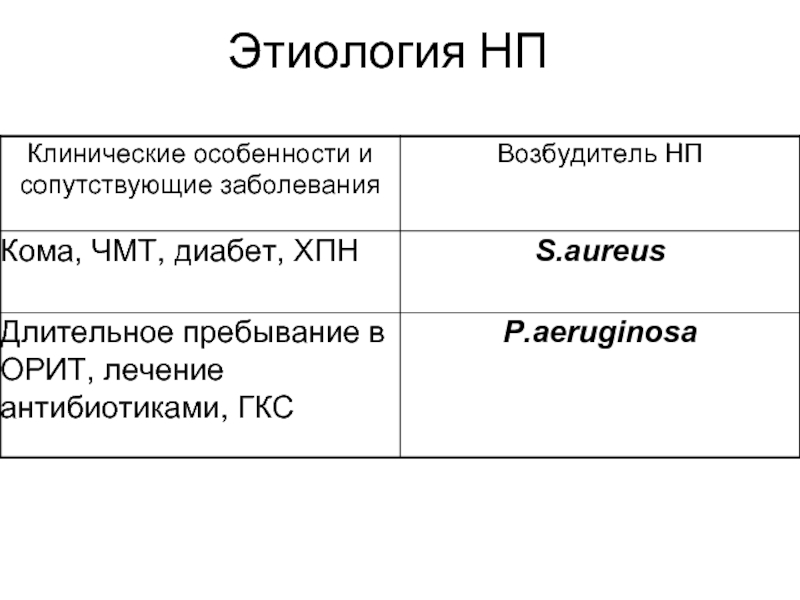
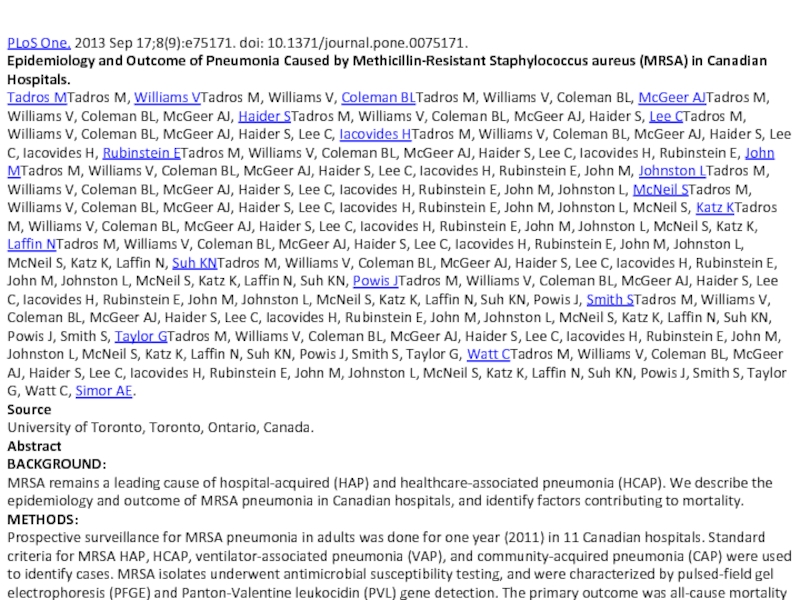
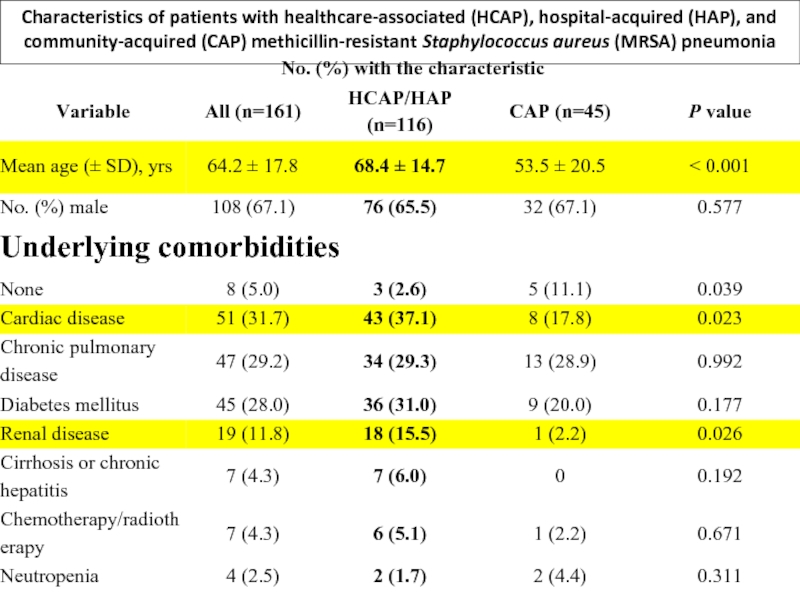
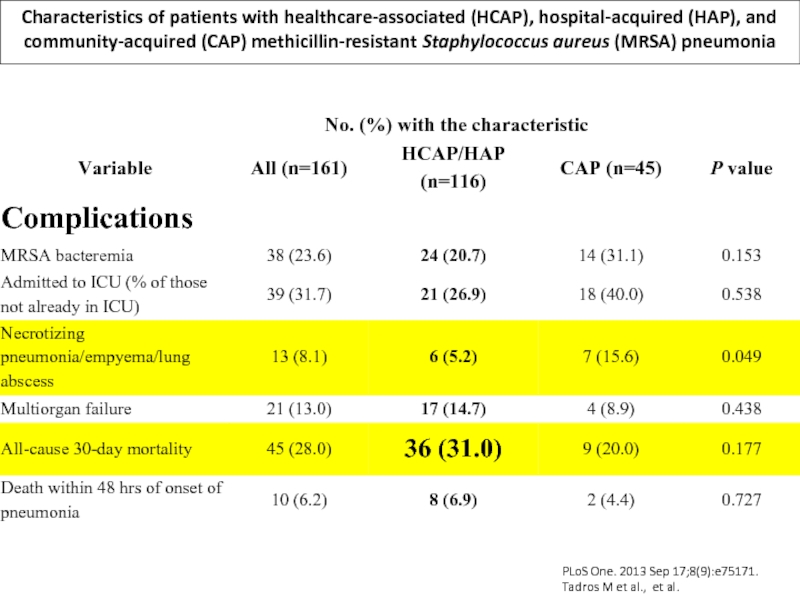
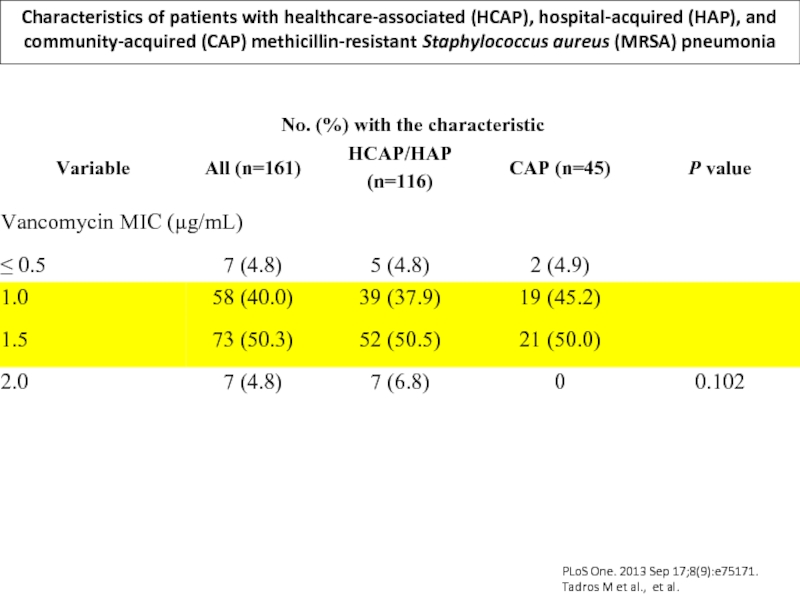
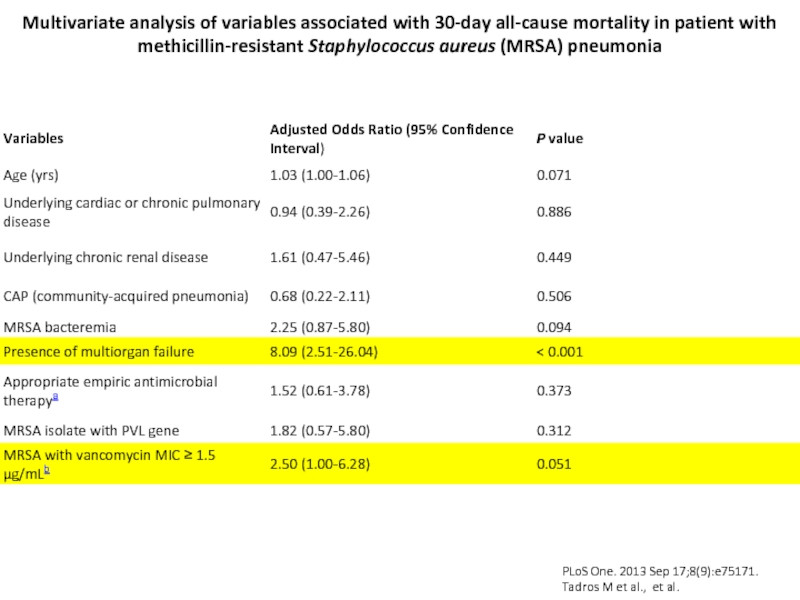
![Int J Infect Dis. 2013 Sep 11. pii: S1201-9712(13)00249-X. doi: 10.1016/j.ijid.2013.07.014. [Epub ahead of print]Acinetobacter](/img/tmb/2/167255/fdbed62a6068576897e262b79e9fb607-800x.jpg)
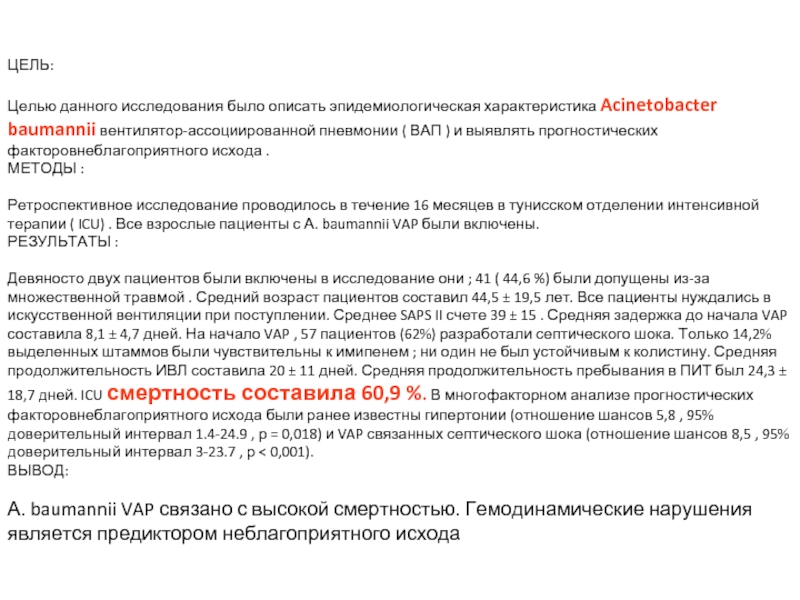
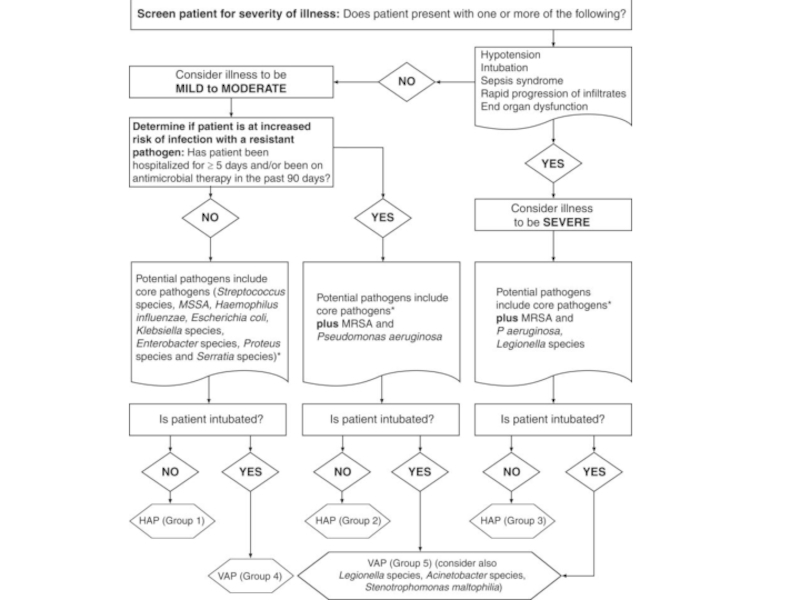
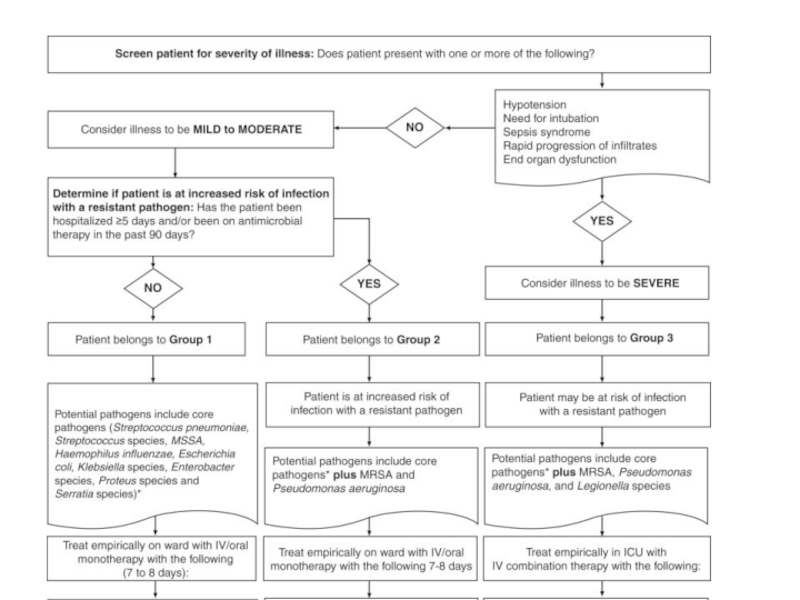
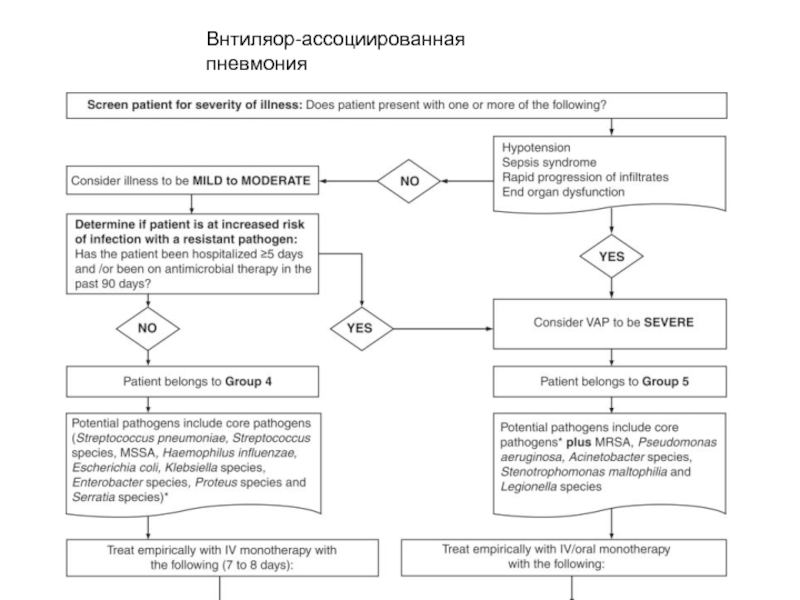
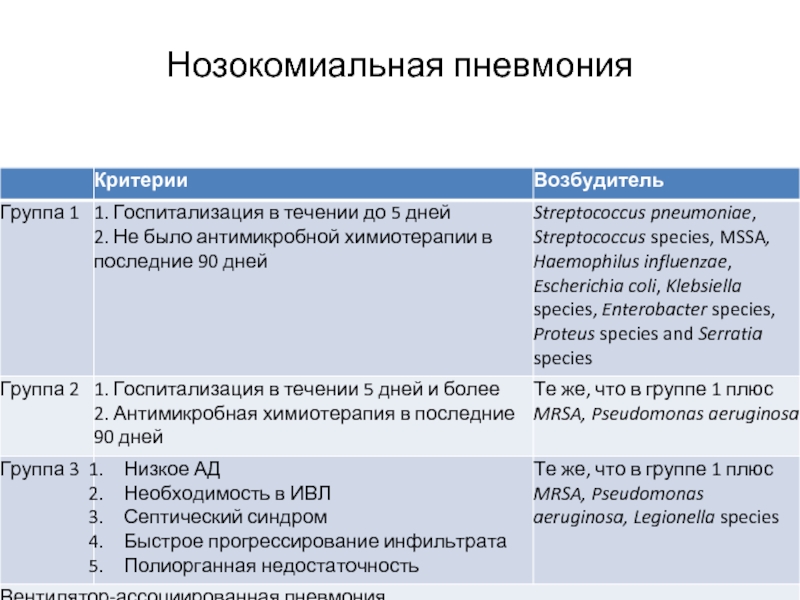
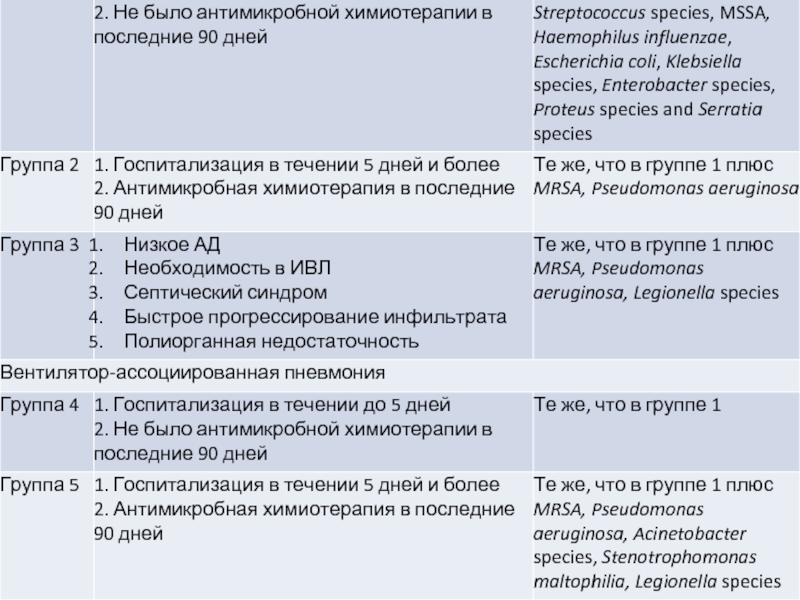
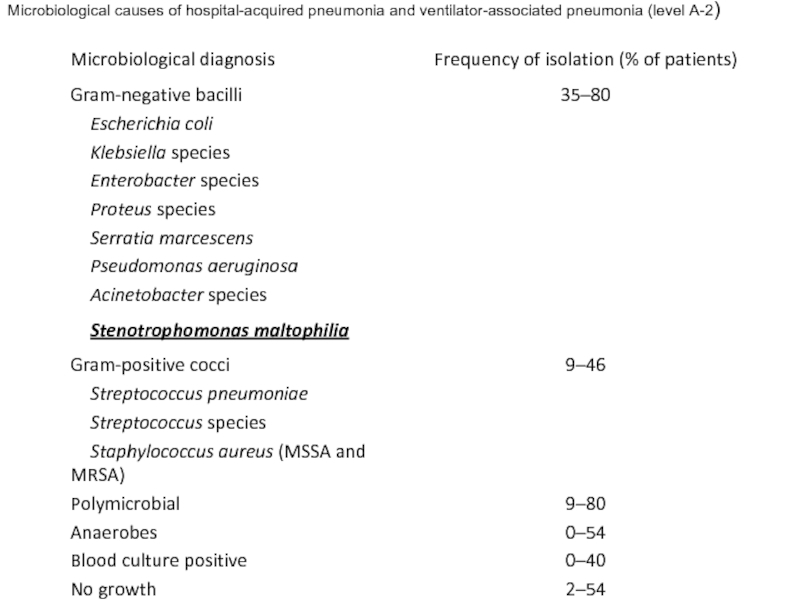
![Род Stenotrophomonas включает 5 видов [25], из которых клинически значимым к настоящему времени считается только](/img/tmb/2/167255/9163be8e012c668ba3ae39cd32c2361c-800x.jpg)
